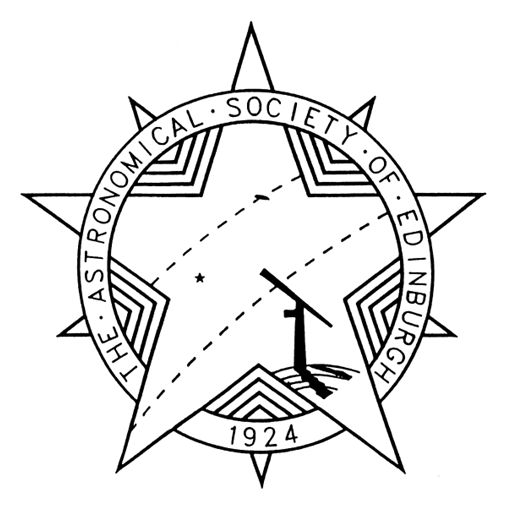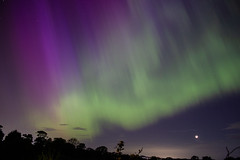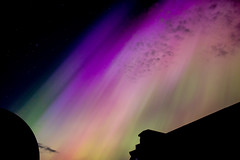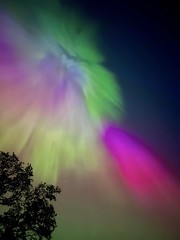Monthly Archives: January 2018
Scotland’s Sky in February, 2018
Conspicuous Jupiter leads trio of planets before dawn

The maps show the sky at 22:00 GMT on the 1st, 21:00 on the 15th and 20:00 on the 28th. (Click on map to enlarge)
February’s main planetary focus is the trio of Jupiter, Mars and Saturn in our predawn sky while Venus and Mercury begin spells of evening visibility later in the period. As the night falls at present, though, our eyes are drawn inevitably to the sparkling form of Orion in our south-eastern sky. Perhaps the only constellation that most people can recognise, it is one of the very few that has any resemblance to its name.
It is easy to imagine Orion’s brighter stars as the form of a man, the Hunter, with stars to represent his shoulders and knees, and three more as his Belt. Fainter stars mark his head, a club and a shield, the latter brandished in the face of Taurus the Bull, while his Sword, hanging at the ready below the Belt, contains the fuzzy star-forming Orion Nebula, mentioned here last month.
Since he straddles the celestial equator, the whole of Orion is visible worldwide except from the polar regions. Observers in the southern hemisphere, though, are seeing him upside down as he crosses the northern sky during their summer nights. For us, Orion passes due south about one hour before our map times.
The line of Orion’s Belt slants down to our brightest nighttime star, Sirius, in Canis Major which is one of the two dogs that accompany Orion around the sky. The other, Canis Minor, stands higher to its left with the star Procyon. This, with Sirius and Betelgeuse in Orion’s shoulder, form the equilateral Winter Triangle whose centre passes some 30° high in the south at our map times.
The Belt points up to Aldebaran in Taurus and, much further on, to the eclipsing variable star Algol in Perseus which we highlighted last month. This month Algol dims to its minimum brightness at 22:09 GMT on the 7th, 18:58 on the 10th and 23:54 on the 27th.
The Sun climbs 9.5° northwards during February as sunrise/sunset times for Edinburgh change from 08:07/16:46 on the 1st to 07:07/17:45 on the 28th.
A total lunar eclipse occurs when the Moon is full on 31 January, but finishes before the Moon rises for Scotland. The Moon lies close to Regulus in Leo on the 1st and is at last quarter on the 7th. The new moon on the 15th brings a partial solar eclipse for Antarctica and southernmost South America. First quarter occurs on the 23th when, late in the afternoon, it occults Aldebaran – a telescope should show the star disappearing behind the Moon from 16:37 to 17:47 as viewed from Edinburgh. The Moon is not full again until 2nd March.
Jupiter, brighter than Sirius and the most conspicuous of our morning planets, rises at Edinburgh’s east-south-eastern horizon at 02:27 on the 1st and 00:51 by the 28th, and climbs to pass 17° high in the south before we lose it in the dawn twilight. Creeping eastwards in Libra, it brightens from magnitude -2.0 to -2.2 while, viewed telescopically, its cloud-banded disk swells from 36 to 39 arcseconds is diameter.
Mars follows some 12° to the left of Jupiter on the 1st, rising in the south-east at 03:41 and shining at magnitude 1.2 less than a Moon’s breadth below the multiple star Beta Scorpii, Graffias, as they climb into the south. The planet tracks quickly eastwards against the stars, sweeping 4° north of the magnitude 1.0 red supergiant Antares on the 10th and making this a good month to compare the two. The name Antares means “rival to Mars” and both are reddish and, this month at least, very similar in brightness. By the 28th, Mars stands 27° from Jupiter, rises at 03:24 and shines at magnitude 0.8.
Saturn, now also a morning object as it creeps eastwards above the Teapot of Sagittarius, rises in the south-east at 06:13 on the 1st and by 04:37 on the 28th when it shines at magnitude 0.6 and is 17° to the left of Mars before dawn. Catch the waning Moon above-left of Jupiter before dawn on the 8th, above Mars on the 9th and above-right of Saturn on the 11th.
Venus is brilliant at magnitude -3.9 as it pulls slowly away from the Sun into our evening twilight but we need a clear west-south-western horizon to see it. Its altitude at sunset doubles from 4° on the 8th to 8° by the 28th, by which day it sets more than one hour after the Sun. As the month ends, use binoculars to look a couple of degrees below-right of Venus for the fainter magnitude -1.3 glow of Mercury as the small innermost planet begins its best evening apparition of the year.
For a real challenge, try to spy the very young Moon when it lies just 1.2° below-left of Venus soon after sunset on the 16th. Barely 20 hours old, the Moon is only 0.7% illuminated and may be glimpsed as the thinnest of crescents. It is more noticeable, and impressively earthlit, as it climbs steeply away from the Sun over the following days.
Alan Pickup



